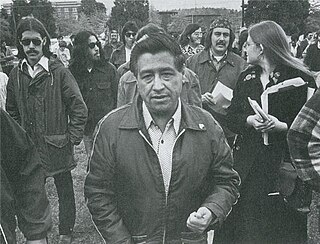Brown Berets
In 1967, Arellanes and some of her friends visited La Piranya, a coffeehouse owned and operated by the Brown Berets. Arellanes met future Prime Minister of the Brown Berets, David Sánchez, and was encouraged by Sánchez to join the Berets at the coffeehouse. She began attending community meetings and events, and eventually decided to join. [3] : 131 In 1968, Arellanes was named the Minister of Finance and Correspondence, the first female minister of the Brown Berets. [4] Early in her career she represented the Brown Berets when they were awarded the Ghetto Freedom Award by the Greater Los Angeles Urban League in 1968. [3] The Brown Berets worked to raise their community by calling for improvement on education and employment, demanding more resources for the Chicano/a movement, and exposing police brutality against the Mexican-American people. [4] The first important move the Brown Berets made was their involvement in the 1968 East L.A. blowouts, which Arellanes had been forced to sit out by her boss at the time. [3] She was informed that her friend and companion Andrea Sánchez was arrested by Sergeant Arias of the Special Operation Conspiracy Force of LAPD under the assumption that he had arrested Arellanes. She was being watched by police because of her involvement in the Brown Berets. [3]
Arellanes organized marches during her time with the Brown Berets in partnership with the East L.A. Blowouts, in opposition to policy brutality against Chicanos, and for El Barrio Free Clinic. [3] In 1969 she arranged for the Brown Berets to use a tank for their float in the September 16 parade. [3] She requested it without informing the clinic it would be used for Brown Berets because of the known sentiments against the Brown Berets. [3] Arellanes was also in charge of fundraising for the Berets on a couple occasions. She organized a "Zoot Suit Party" where they made money selling beer to fund the Brown Berets' activities. [3] Arellanes, among many other women Berets, chiefly arranged and assembled the newsletter that went out for Mexicans and Chicanos to read, titled La Causa. [5] However, limited resources and funds made the production and distribution of the paper difficult. [3]
East L.A. Free Clinic / El Barrio Free Clinic
In 1969, David Sanchez brought the news about the Barrio Free Clinic which Arellanes was given the responsibility of coordinating. The Brown Berets created the East L.A. Free Clinic, later to be known as El Barrio Free Clinic, on Whittier Boulevard. [5] Arellanes headed the clinic for the Brown Berets, partnering with professionals that offered medical services "including drug addiction counseling, immunizations, physical exams, STI screenings and even small surgical procedures." [5] The clinic struggled to fundraise because of its casual approach in its "provided counseling for unwanted pregnancies." [5] Though it funds were not always steady, the clinic provided a space where young people in L.A. felt safe in receiving important services, even giving comfort to those who were worried of attaining health services because of their legal status in the United States. [6] Coordinating El Barrio Free Clinic, Arellanes had helped better the name of the Brown Berets, who had been seen as an outrageous radical group, as many had viewed the Black Panthers during this time. [4] In July 1969, Arellanes had become the official Clinic Director of the Barrio Free Clinic. [4] El Barrio Free Clinic is what Arellanes called, "the most significant contribution of the East L.A. Brown Berets." [3] While the clinic significantly aided the Brown Berets in their reputation within the community, it led to the departure of many female Brown Berets because of the gendered distribution of work that it came with. [6] [5] Arellanes faced conflict in her duty to maintain the family-friendly environment of the Clinic while the men of the organization used the Clinic as a location of socialization, where she would be forced to remove their mess frequently to preserve its orderly image for its patients. [5] [3] [4]

While they got along for the most part, the women were expected to work the clinic and the men took little part in volunteering and participating in the daily functions of the clinic. [3] [4] [5] The Beret women were not initially aware of their "second-class" membership within the organization because they "never openly expressed macho attitude," but the clinic enabled the women to recognize the difference in the roles of the men and women in the Brown Berets. [3] [4] [5] Arellanes mentions in her testimony that many of the women left the Brown Berets around the same time in February 1970 due to what they saw as gender inequality perpetuated by the male Brown Berets in the Chicano movement. [3] She said this was because they "found that the Brown Beret men have oppressed us more than the pig system has." [3] : 134 They left by verbal resignation but wrote letters to other chapters explaining their reasons for leaving. [3] The letter was signed, "Con Che!" due to Che Guevara's stance on equality among the sexes.










